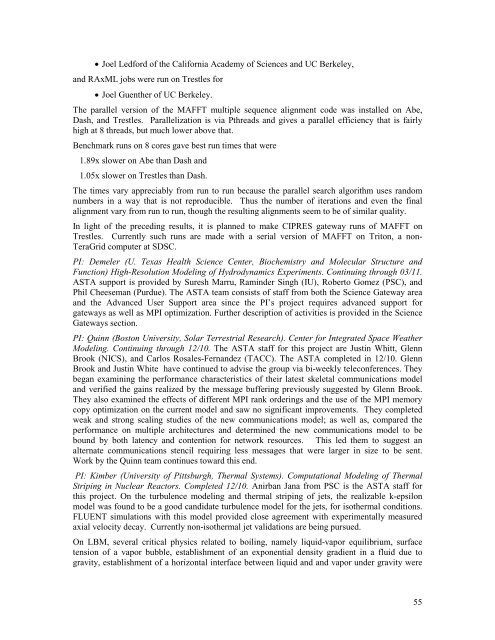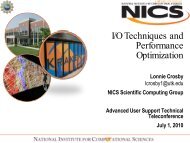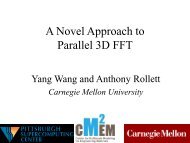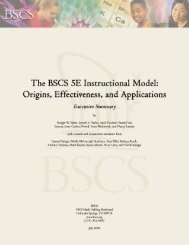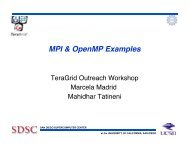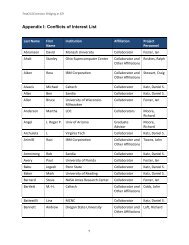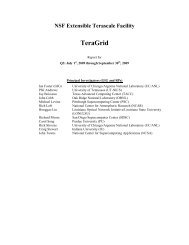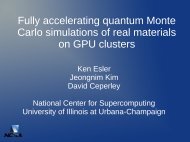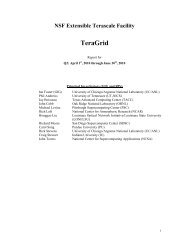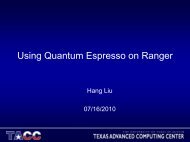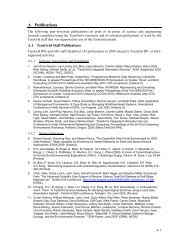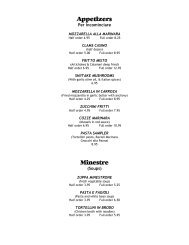TGQR 2010Q4 Report.pdf - Teragridforum.org
TGQR 2010Q4 Report.pdf - Teragridforum.org
TGQR 2010Q4 Report.pdf - Teragridforum.org
Create successful ePaper yourself
Turn your PDF publications into a flip-book with our unique Google optimized e-Paper software.
• Joel Ledford of the California Academy of Sciences and UC Berkeley,<br />
and RAxML jobs were run on Trestles for<br />
• Joel Guenther of UC Berkeley.<br />
The parallel version of the MAFFT multiple sequence alignment code was installed on Abe,<br />
Dash, and Trestles. Parallelization is via Pthreads and gives a parallel efficiency that is fairly<br />
high at 8 threads, but much lower above that.<br />
Benchmark runs on 8 cores gave best run times that were<br />
1.89x slower on Abe than Dash and<br />
1.05x slower on Trestles than Dash.<br />
The times vary appreciably from run to run because the parallel search algorithm uses random<br />
numbers in a way that is not reproducible. Thus the number of iterations and even the final<br />
alignment vary from run to run, though the resulting alignments seem to be of similar quality.<br />
In light of the preceding results, it is planned to make CIPRES gateway runs of MAFFT on<br />
Trestles. Currently such runs are made with a serial version of MAFFT on Triton, a non-<br />
TeraGrid computer at SDSC.<br />
PI: Demeler (U. Texas Health Science Center, Biochemistry and Molecular Structure and<br />
Function) High-Resolution Modeling of Hydrodynamics Experiments. Continuing through 03/11.<br />
ASTA support is provided by Suresh Marru, Raminder Singh (IU), Roberto Gomez (PSC), and<br />
Phil Cheeseman (Purdue). The ASTA team consists of staff from both the Science Gateway area<br />
and the Advanced User Support area since the PI’s project requires advanced support for<br />
gateways as well as MPI optimization. Further description of activities is provided in the Science<br />
Gateways section.<br />
PI: Quinn (Boston University, Solar Terrestrial Research). Center for Integrated Space Weather<br />
Modeling. Continuing through 12/10. The ASTA staff for this project are Justin Whitt, Glenn<br />
Brook (NICS), and Carlos Rosales-Fernandez (TACC). The ASTA completed in 12/10. Glenn<br />
Brook and Justin White have continued to advise the group via bi-weekly teleconferences. They<br />
began examining the performance characteristics of their latest skeletal communications model<br />
and verified the gains realized by the message buffering previously suggested by Glenn Brook.<br />
They also examined the effects of different MPI rank orderings and the use of the MPI memory<br />
copy optimization on the current model and saw no significant improvements. They completed<br />
weak and strong scaling studies of the new communications model; as well as, compared the<br />
performance on multiple architectures and determined the new communications model to be<br />
bound by both latency and contention for network resources. This led them to suggest an<br />
alternate communications stencil requiring less messages that were larger in size to be sent.<br />
Work by the Quinn team continues toward this end.<br />
PI: Kimber (University of Pittsburgh, Thermal Systems). Computational Modeling of Thermal<br />
Striping in Nuclear Reactors. Completed 12/10. Anirban Jana from PSC is the ASTA staff for<br />
this project. On the turbulence modeling and thermal striping of jets, the realizable k-epsilon<br />
model was found to be a good candidate turbulence model for the jets, for isothermal conditions.<br />
FLUENT simulations with this model provided close agreement with experimentally measured<br />
axial velocity decay. Currently non-isothermal jet validations are being pursued.<br />
On LBM, several critical physics related to boiling, namely liquid-vapor equilibrium, surface<br />
tension of a vapor bubble, establishment of an exponential density gradient in a fluid due to<br />
gravity, establishment of a horizontal interface between liquid and and vapor under gravity were<br />
55


